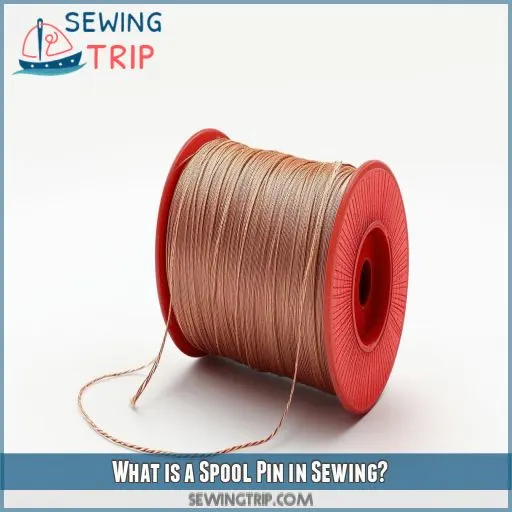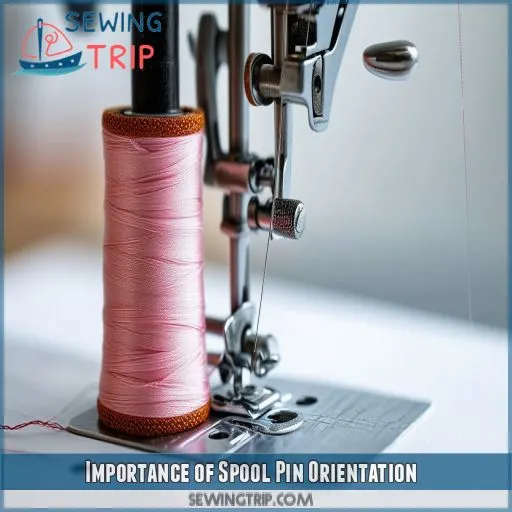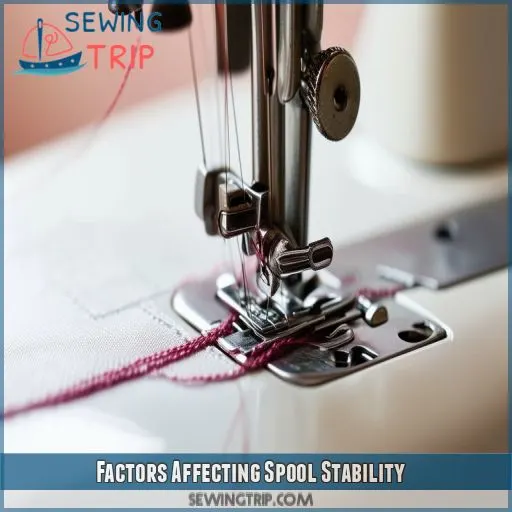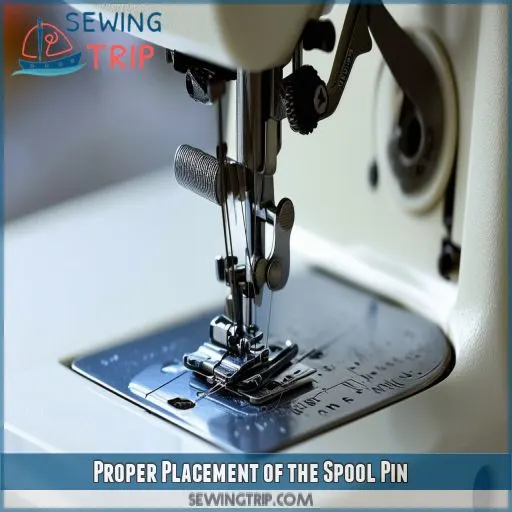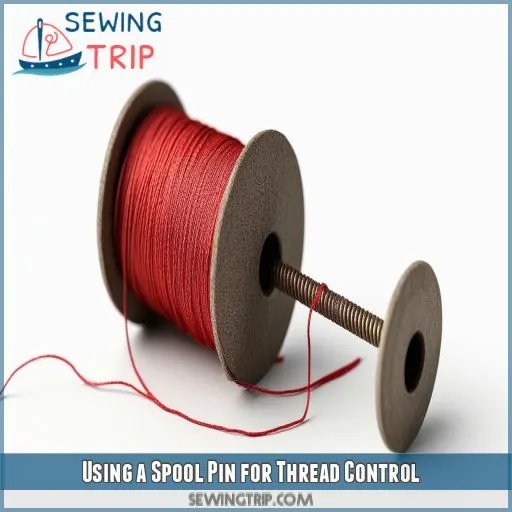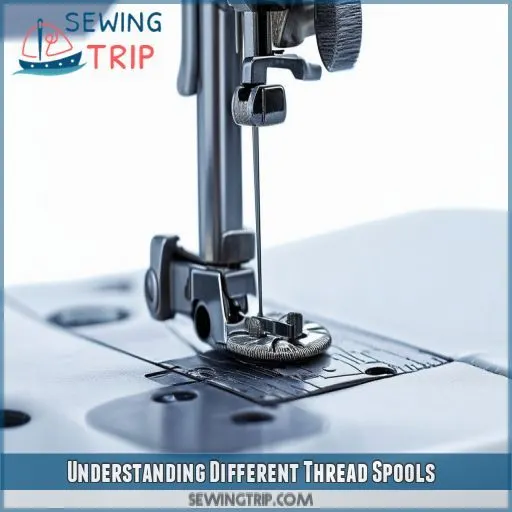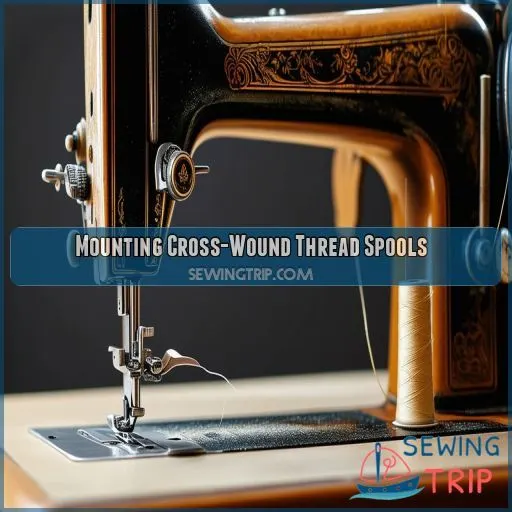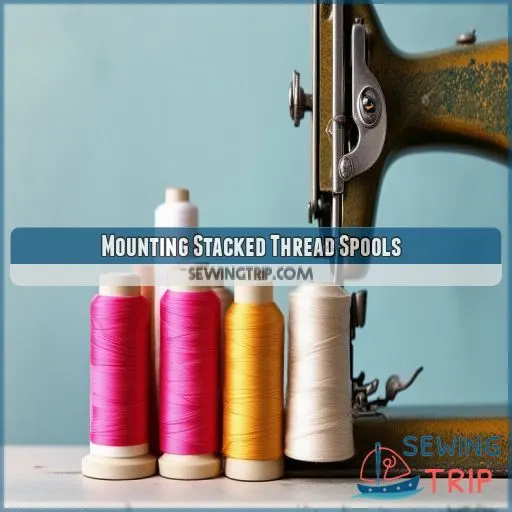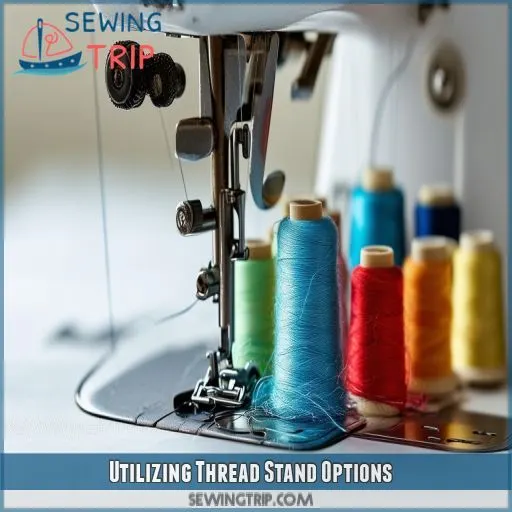This site is supported by our readers. We may earn a commission, at no cost to you, if you purchase through links.
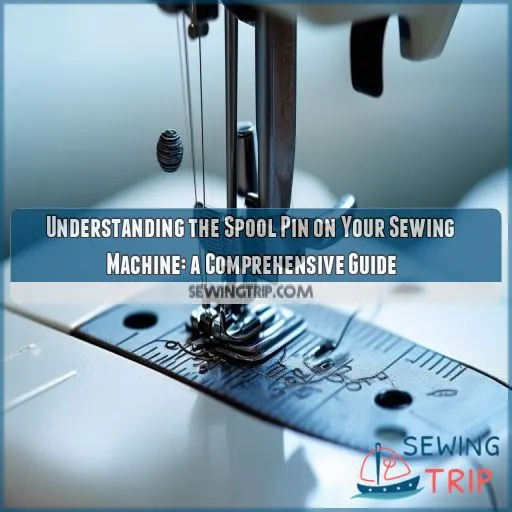
This guide will help you understand what the spool pin does on a sewing machine and how to use it effectively.
You’ll learn about different types of spool pins, their placement, and how they affect thread tension.
Table Of Contents
- Key Takeaways
- What Does the Spool Pin Do on a Sewing Machine?
- What is a Spool Pin in Sewing?
- Importance of Spool Pin Orientation
- Factors Affecting Spool Stability
- Proper Placement of the Spool Pin
- Using a Spool Pin for Thread Control
- Spool Pin Selection Considerations
- Understanding Different Thread Spools
- Mounting Cross-Wound Thread Spools
- Mounting Stacked Thread Spools
- Utilizing Thread Stand Options
- Frequently Asked Questions (FAQs)
- Conclusion
Key Takeaways
- The spool pin is the unsung hero of your sewing machine, keeping your thread in check like a strict but loving parent. It’s the backstage manager ensuring the show goes on without a hitch!
- Proper spool pin orientation is like finding the perfect dance partner – it keeps your thread flowing smoothly and prevents those pesky tension tangles. Left or right, vertical or horizontal – it’s all about finding your sewing groove.
- Choosing the right spool pin is like picking the perfect pair of shoes – it needs to match your thread type, spool size, and sewing style. One size doesn’t fit all in the world of stitching!
- Don’t be afraid to think outside the spool! Thread stands and DIY spool pins can be your secret weapons for tackling tricky projects. Who knew a humble pencil could be a sewing superhero in disguise?
What Does the Spool Pin Do on a Sewing Machine?
The spool pin on your sewing machine is an essential component that holds your thread spool in place. It’s like a mini-helper, ensuring smooth thread delivery as you sew. This pin plays a key role in maintaining proper tension and preventing tangles.
You’ll find it on the top or side of your machine, and its orientation matters for best performance. Right-handed? Your spool should be to the left. Lefty? Keep it to the right.
The spool pin’s job is to keep your thread flowing freely, allowing you to focus on creating beautiful stitches. There’s more to this tiny but mighty part than meets the eye!
What is a Spool Pin in Sewing?
A spool pin is an essential component of your sewing machine, playing a critical role in facilitating smooth thread movement and maintaining spool stability. It’s like the unsung hero that makes sure your thread behaves just right, preventing any tangles and keeping the tension consistent.
Now, you might be wondering about the different types of spool pins out there. Well, they come in various materials, sizes, and types, each with its own unique purpose. For instance, you’ve got metal and plastic spool pins, and the size you choose depends on the thread spool you’re working with.
And speaking of thread spools, did you know that the way you orient them matters too? It’s like a little dance between the spool and the pin, making sure the thread feeds off in just the right way.
Stay tuned as we unravel the intricacies of spool pin orientation and how it affects your sewing projects.
Importance of Spool Pin Orientation
Now that you understand the purpose of a spool pin, let’s explore the significance of its orientation. This seemingly minor detail can greatly impact your sewing experience, particularly with regard to thread flow and tension control.
- Right-Handed Users: For right-handed individuals, the conventional setup is most effective. Position the spool to the left of the machine, allowing the thread to flow effortlessly without tangling.
- Left-Handed Users: For left-handed individuals, the setup should be mirrored. Place the spool to the right of the machine. This simple adjustment facilitates comfortable sewing and efficient thread management.
- Thread Flow: The spool pin orientation affects the trajectory of the thread as it unwinds from the spool. A suitable setup minimizes tangles and ensures smooth thread feeding through the machine.
- Tension Control: Spool pin orientation is fundamental in maintaining consistent tension. Appropriate placement prevents excessively loose or tight threads, enabling precise sewing and avoiding frustrating snags.
- Spool Stability: While not directly related to orientation, it’s important to emphasize the importance of a stable spool. A secure spool pin prevents the spool from rotating or wobbling, keeping the thread taut and ready for use.
Factors Affecting Spool Stability
Guaranteeing spool stability on your sewing machine is contingent upon the appropriate nut diameter, correct spool pin placement, and proper thread orientation. These factors preclude thread snarls and guarantee smooth and consistent sewing.
Nut Diameter Impact
Regarding your spool pin’s design and stability, the nut diameter plays a critical role. A nut that’s too large can leave your spool unsupported, while a smaller one enhances stability by securing the spool firmly in place.
Spool Pin Placement
Spool pin placement matters for stability and ease of use. Typically, the spool pin is placed on top of the machine for visibility, or on the side for easy access. Vertical placement is preferred for thread stability, especially with stacked thread spools. If your machine has horizontal placement, use a lid or cover to secure the threads.
Thread Orientation
Thread orientation is essential for achieving spool stability. Here are some factors to mull over:
- Thread tension: Adjust the thread tension appropriately for your thread type.
- Spool size: Larger spools may necessitate a different setup compared to smaller ones.
- Spool material: The material of the spool can influence how the thread feeds off it.
Proper Placement of the Spool Pin
Now that you grasp the factors influencing spool stability, let’s focus on the appropriate placement of the spool pin, which is vital for ideal sewing machine performance.
The positioning of the spool pin on your sewing machine can vary, but there are a few common locations:
| Placement | Description |
|---|---|
| Top | Offers visibility and convenient access to the spool pin, often preferred for ease of use. |
| Side | Allows for swift access and can be beneficial when changing spools frequently. |
| Back | Prevents thread interference and ensures a seamless thread path, suitable for specific sewing projects. |
When considering spool pin placement, it’s crucial to consider the type of thread you’re using. For instance, cross-wound spools usually require a horizontal spool pin, while stacked spools perform best with a vertical spool pin.
Additionally, the position of the spool pin can affect the thread tension. By placing the spool pin to the left or right, you can adjust the thread tension to suit your sewing needs, whether you’re right-handed or left-handed.
Using a Spool Pin for Thread Control
Now that you know where to place your spool pin, let’s discuss how it helps with thread control. The spool pin plays a vital role in maintaining the right tension and ensuring smooth stitching. Here are some key points to keep in mind:
- Spool Pin Tension: Adjust the spool pin tension according to your thread thickness. Too much tension can restrict thread flow, while too little can lead to tangles.
- Spool Pin Accessories: Use a foam pad and a spool cap to enhance thread control. The foam pad provides a snug fit, while the spool cap prevents the spool from spinning off.
- Spool Pin Materials: Metal spool pins offer durability, while plastic ones may be more affordable but less long-lasting.
- Spool Pin Maintenance and Customization: Regularly check your spool pin for residue or glue, which can hinder thread movement. You can also customize your spool pin setup by using extensions to accommodate more spools.
Spool Pin Selection Considerations
When selecting a spool pin, you’ll need to take into account thread spool orientation, overall spool stability, and how well the pin matches the thread and needle type. Your choice should guarantee smooth thread flow and consistent tension to facilitate efficient sewing.
Thread Spool Orientation
When placing your thread spool on the pin, consider the following: your dominant hand, the order of thread colours, and the spool pin’s placement. Right-handed users should place the spool to the left, and left-handed users to the right. Threads should come off the spool in the designated order, and different colours require different spooling orders.
| Placement | Considerations |
|---|---|
| Left | Right-handed users |
| Right | Left-handed users |
| N/A | Thread colour order |
Spool Stability
For effective spool stability, consider the following:
- Spool nut size: A smaller nut diameter enhances stability by firmly holding the spool.
- Spool pin placement: Vertical placement is preferred for stability, especially with horizontal spool pins.
- Spool pin tension: Adjust tension according to thread thickness to prevent tangling.
- Spool pin height: The pin should be positioned to allow free movement of the spool when pulling the thread.
- Spool pin durability: Metal pins generally offer greater durability than plastic ones.
Spool Pin Selection
When selecting a spool pin, consider factors like thread size, needle strength, fabric thickness, thread stickiness, and stitch type. The spool pin should complement your thread and needle choices, ensuring smooth sewing and minimizing tangles.
Understanding Different Thread Spools
In regard to thread spools, understanding the various types and their distinct characteristics is imperative for achieving ideal sewing outcomes. Here’s what you should know:
- Thread Winding Patterns: There are two prevalent types of thread spools: cross-wound and stacked. Each type has a unique winding pattern that influences how the thread feeds off the spool.
- Cross-Wound Spools: These spools exhibit an "X" pattern formed by the thread. The thread feeds off one end of the spool.
- Stacked Spools: Threads on these spools are wound in a manner that creates a stack. The thread feeds off the side of the spool.
- Spool Cap Usage: Spool caps fulfill an essential role in securing thread spools, particularly when using a horizontal spool pin. They prevent the spool from spinning off, ensuring consistent thread delivery.
- Mounting Thread Spools: Correctly mounting thread spools is essential. Cross-wound spools are typically mounted on horizontal spool pins, while stacked spools are placed on vertical spool pins. This ensures smooth thread feeding and prevents tangling.
- Tips for Ideal Performance: Guarantee smooth thread feeding by guiding it over the top of the spool. When using a vertical spool pin with a cross-wound spool, a foam pad and spool cap can enhance stability.
Mounting Cross-Wound Thread Spools
When using a horizontal spool pin, be sure to mount the larger end of the cross-wound thread spool to the back of the pin. Additionally, securely fit a spool cap over the end of the thread spool to prevent it from spinning off the pin.
Using a Horizontal Spool Pin
When using a horizontal spool pin, it’s important to consider several factors to maintain stability and ensure smooth thread flow.
The pin placement, thread tension adjustment, and spool cap usage are key elements to focus on.
The pin should be positioned securely, and the thread tension should be adjusted to accommodate the thickness of the thread. This simple step will prevent tangles and keep your thread flowing freely.
For cross-wound thread spools, remember to always mount the larger end of the spool to the back of the pin.
Proper Spool Cap Placement
After placing your cross-wound thread on the horizontal spool pin, it’s imperative to secure it with the right spool cap. Choose a cap that fits snugly against the spool’s end, preventing it from spinning off.
Different spool cap styles and types are available, so select one that matches your thread spool’s size. Store extra spool caps nearby for quick access when switching threads.
Proper usage guarantees smooth thread flow and consistent tension.
Mounting Stacked Thread Spools
For stacked thread spools, you’ll want to use a vertical spool pin on your sewing machine. Place the spool on top of the pin, ensuring it can rotate freely as you pull the thread during sewing.
Using a Vertical Spool Pin
When using a vertical spool pin for stacked thread spools, you’ll want to optimize thread flow and adjust tension. Here’s what you need to know:
- Place the spool on top of the pin
- Make sure proper placement for smooth thread release
- Consider spool pin durability (metal often outlasts plastic)
- Explore different placement options on your machine
Ensuring Free Movement of the Spool
When using a vertical spool pin for stacked thread spools, guarantee free movement is paramount. Place the spool on top, allowing it to rotate smoothly. Check that the thread guide and spool cap aren’t impeding rotation.
Adjust the spool nut for proper tension without over-tightening. Correct spool alignment is essential for consistent thread flow.
If you notice any resistance, realign the spool and double-check your setup. Smooth rotation equals happy sewing!
Utilizing Thread Stand Options
When your sewing machine’s built-in spool pin isn’t cutting it, thread stands come to the rescue. You’ve got options galore! Free-standing thread stands are versatile champs, handling both cross-wound and stacked spools with ease. If you’re a thread enthusiast, consider a Superior Threads stand – it’s like a Swiss Army knife for spools, accommodating everything from tiny bobbins to hulking cones.
For the multi-taskers among you, multiple-spool holders are a game-changer. Mount them on your machine’s back and juggle various threads like a pro. Need more space? Extensions have got your back, literally.
Don’t forget the details: position your thread stand near the machine’s end and use the thread guide to keep things flowing smoothly. And here’s a pro tip: a foam pad can be your best friend when mounting cross-wound thread on a vertical pin.
Frequently Asked Questions (FAQs)
What is the function of the spool pin on a sewing machine?
You’ll find the spool pin essential for your sewing projects. It securely holds your thread spool, ensuring smooth thread flow and consistent tension. This little hero prevents tangling and keeps your stitching on track. It’s a small part with a big job!
What do you place on the spool pin?
You’ll place a thread spool on the spool pin. It’s where you’ll mount your thread, whether it’s a cross-wound or stacked spool. Don’t forget to use the appropriate spool cap to keep it secure and spinning smoothly.
What is the extra spool pin for?
Ever feel like you’re juggling threads? That’s where the extra spool pin comes in handy. It’s your sewing machine’s sidekick, letting you work with multiple thread colors or types simultaneously. You’ll breeze through those two-tone projects effortlessly.
What does the spool holder do on a sewing machine?
The spool holder on your sewing machine keeps your thread in place and guarantees smooth feeding. It’s like a mini-assistant, preventing tangles and maintaining tension as you sew. Without it, you’d be wrestling with runaway thread spools!
Can you use multiple spool pins simultaneously?
Groovy, thread enthusiasts! You can totally use multiple spool pins at once. They’re great for twin needle sewing, decorative stitching, or when you’re working with different thread types. It’s like having a DJ booth for your threads!
How often should spool pins be replaced?
You don’t typically need to replace spool pins unless they’re damaged. They’re durable parts that can last as long as your machine. However, if you notice thread snagging or uneven tension, it’s worth checking your spool pin’s condition.
Are there alternative materials for homemade spool pins?
A needle in a haystack? Not quite. You can craft DIY spool pins from everyday items like dowels, skewers, or even pencils. Just make certain they’re smooth and sturdy. Remember, your machine’s tension may need adjusting for these creative alternatives.
Do embroidery machines use different types of spool pins?
Yes, embroidery machines often use specialized spool pins. You’ll find vertical and horizontal options, as well as thread stands. These accommodate different thread types and sizes, ensuring smooth feeding for intricate designs. Always check your machine’s manual for compatibility.
Can spool pin height affect thread tension?
Yes, spool pin height can affect thread tension. You’ll notice changes in tension if the pin’s too high or low. It’s important to maintain the right height for smooth thread flow and consistent stitching. Adjust as needed for desired results.
Conclusion
Like the director of an orchestra, the spool pin organizes the smooth flow of thread in your sewing machine. Comprehending the function of the spool pin on a sewing machine is essential for achieving flawless stitches.
By selecting the appropriate spool pin, positioning it correctly, and considering factors such as thread orientation and spool stability, you’ll guarantee proper thread tension and control.
Whether you’re working with cross-wound or stacked thread spools, mastering spool pin usage will enhance your sewing projects.

